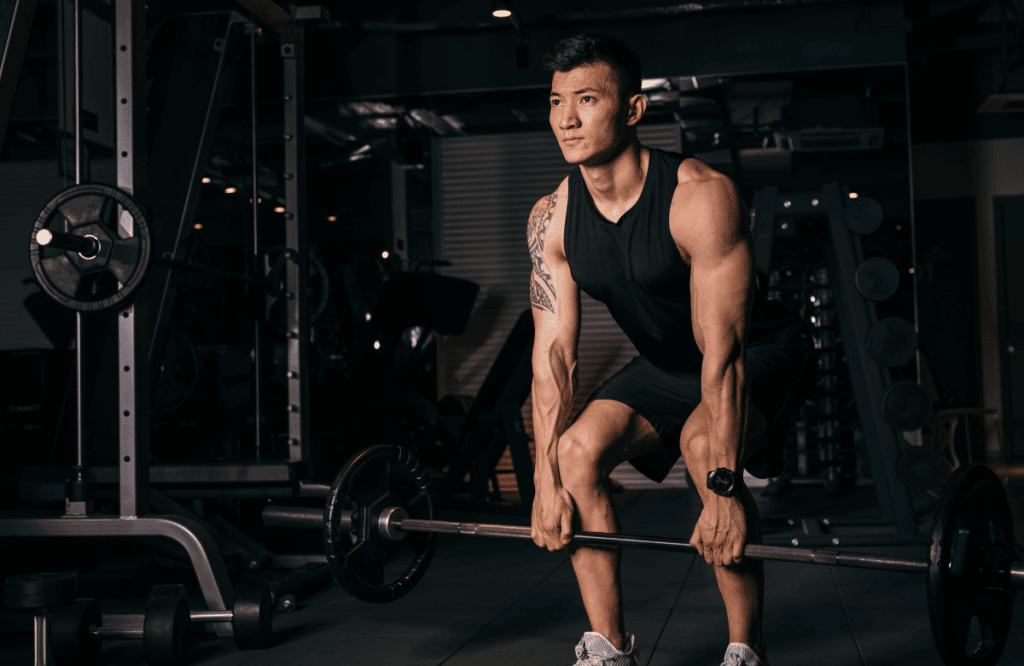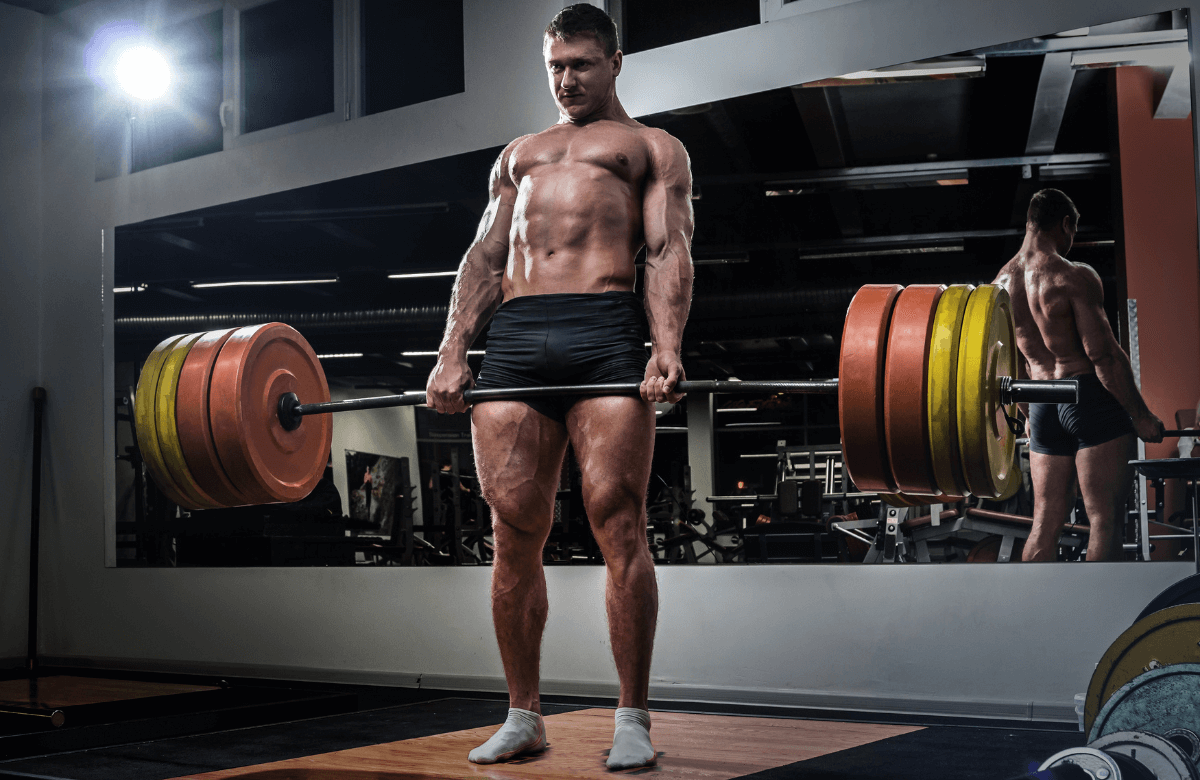Deadlifting is one of the core exercises along with squatting and bench pressing. If you spend more than ten minutes in the gym you’ll definitely hear someone talking about their deadlifting goals. Since the deadlift is such a widely known and desired exercise, we thought we’d help you mix it up and give you 10 different types of deadlifts to try and why you should add them to your routine.
Whether you’re bored and want to try something new or you’re looking for a deadlift variation to help improve your weaknesses, this article is for you.

Jump to:
- First Off, What Is A Deadlift?
- The Variations:
- Kettlebell Deadlift
- Deficit Deadlift
- Block Pull Deadlift
- Snatch Grip Deadlift
- Romanian Deadlift
- Paused deadlift
- Sumo deadlift
- Rack Pull Deadlift
- Trap Bar Deadlift
- Suitcase Deadlift
- Is One Type Of Deadlift Better Than The Other?
- Can Deadlifts Help With Lower Back Pain?
- How Often Should You Deadlift?
- Should You Do Deadlifts?
- Is Sumo Deadlift Cheating?
First Off, What Is A Deadlift?
The deadlift is a weight training exercise where the goal is to lift a weighted barbell off the ground repeatedly. Sounds easy enough, right? No. There’s a lot to go into the proper form of a deadlift and there are multiple variations for deadlifts like the most common one; the conventional deadlift.
The Conventional Deadlift
The conventional deadlift (also known as the standard deadlift, traditional deadlift, or regular deadlift) is by far the most talked-about dumbbell deadlift. It’s the type of exercise that if you get better at the deadlift then you’ll get better in every other exercise.
For this exercise, you’re going to start with the barbell on the floor and your feet mid-line underneath it. Keep your feet and hips aligned and have a neutral spine.
As you go to lower yourself to the bar avoid the movement of “bending over” and instead line your fingertips up with the bar and lower yourself straight down. When you grip your hands and arms should be just outside your thighs.
With tension in your hamstrings and glutes, straighten your arms, and squeeze your shoulder blades together. Once everything is tight and in the correct place, lift and push your hips out and forward just enough so they’re touching the bar. Don’t arch your back or lean too far in any direction, this will knock you off balance and cause unnecessary hip and back pain.
Like in most deadlift variations, you’re going to want to push into the floor with your feet and do less of a “pulling” motion to receive the true benefit of the deadlift.
The Variations:
Kettlebell Deadlift
The kettlebell is nearly identical to the conventional deadlift except you’re using a kettlebell and a few minor things. The first one is to make sure when in the starting position that the kettlebell is directly between your ankles and when you grip it you imagine you’re trying to rip the handle apart. With your lats and core muscles engaged, lift with the same movement pattern as the regular deadlift.
Deficit Deadlift
The deficit deadlift is similar to the standard deadlift movement, though instead of standing on the ground you’re going to be on an elevated surface. It doesn’t matter if it’s a small wooden platform or a very thick mat, as long as you’re 1-2 inches off the ground. Any higher and any lower and you’ll lose the biggest benefits. It does have a limited range of motion and that usually means less deep muscle fatigue, but remember not to pick a heavy load you can’t manage, which might result in you breaking the correct form.
Block Pull Deadlift
Block pull deadlifts or also known as a “block pull” or an “elevated deadlift,” are like a regular deadlift, but instead of the barbell sitting on the ground, it’ll be on some sort of elected surface like weight plates or heavy wooden blocks. It helps place a bigger emphasis on the lock-out portion of the deadlift and can really assist in getting you an overall, well-rounded deadlift due to the short range of motion. Just make sure you’re starting position has the bar somewhere between your mid-shin and knee. If you go too high or too low you’ll lose the main benefit of the block pull deadlifts which is building functional strength.
Snatch Grip Deadlift
This deadlift is not only less known, but less desired amongst commercial gym goers mostly because of how difficult it can be. Not only does the snatch grip deadlift require more mobility, but it needs more upper body and grip strength since you’re grabbing the deadlift bar so far away from your body. For this one, many people have to go at a lower weight or use straps to keep the bar from slipping from their hands. Usually, it’s an easier option just to put your index fingers on the widest smooth rings (the hash marks) on the barbell. Luckily this grip deadlift is pretty easy to learn since its stance and movement are identical to the conventional deadlift, you just need very good grip strength!

Romanian Deadlift
The Romanian deadlift (or RDL) is very similar to the standard deadlift as well, except you’re going to lower the bar to just below your knees and back up to the top position over and over again until your set is done without putting it down. This one can typically be done with slightly heavier weights and is a great posterior chain exercise. A good thing to remember for this exercise is to keep a straight, neutral spine and an engaged core to keep those awesome benefits.
Paused deadlift
This exercise is a conventional deadlift with a pause about two inches off the floor. After a few second pause, keep your arms in their usual proper form for the regular deadlift motion and hold your spine neutral and the bar so close to your body it’s dragging against you. This one might require lighter weights and more stability since you’re holding the bar above the ground. If you notice you’re wobbling or tilting too far one way during the pause, check your stance and decrease your weight.
Sumo deadlift
For the sumo deadlift you’re going to change a few key things. For starters, you’re not going to use the common deadlift grip and you’re definitely going to need a wider stance. To get the proper stance, make sure your knees are pointed outwards (the same direction as your toes). In your starting position, you’ll want your shin about a half inch to a full inch away from the deadlift bar. Once you’re ready, push your hips back until your hands reach the deadlift bar. Unlike the conventional deadlift grip, your arms will be shoulder-width apart instead of the outside leg muscles.
And as for grip, this one is better off with a mixed grip (with one palm facing up and the other down). Just make sure to switch which hand is the overhand grip to avoid muscle imbalances. You can also try a hook grip as long as you avoid wider grips that can cause too much strain on the back.
Then, for the lifting portion, you’re going to stand like you would a standard deadlift. Don’t go too fast and keep your arms relaxed as you push from the floor and get to the standing position without arching your back either way. And then do it over and over again until your set is finished.
Rack Pull Deadlift
The rack pull deadlift had the same movement pattern and mechanics as a block deadlift, except a rack pull is done on a squat rack, power rack, or barbell rack ideally with the barbell at knee height. The setup is nearly the same as the standard deadlift except you’re going to start with your shins to the bar. And make sure to remember that the goal here is control. Set the bar down on the rack as quietly as you can. It’s obviously a heavy barbell so it’s not going to be silent, but the idea is to not just drop the barbell.
Trap Bar Deadlift
This exercise can be slightly intimidating to non-advanced lifters since the trap bar isn’t like a normal barbell, but once you get past that you’ll see you don’t have to be an experienced lifter to complete it. The trap bar deadlift has the same starting position and stance as the conventional barbell deadlift, except you’re going to be gripping from the sides. You don’t have to, but we recommend lowering your hips just a little lower to force your body to get more muscle involvement in the legs, which can be carried over to the barbell deadlift to increase speed and stability.
Suitcase Deadlift
Like you would for a trap bar deadlift with your hands on either side of you, the suitcase deadlift is very similar in movement. You’re still applying everything you do in the traditional barbell deadlift, but the barbell will be parallel on one side of you and you’ll lift it only using one hand. The key here is to engage those abdominal muscles and have a very strong overhand grip. This exercise hits those major muscle groups that are in charge of your stability and are often overlooked when training.
Is One Type Of Deadlift Better Than The Other?
We’re going to be honest: no. Which deadlift is best for you really depends on your fitness goals. If you’re wanting to work more of one muscle group over the other, for weight loss, or you’re solely focused on strictly building muscle as fast as possible, the perfect deadlift variations are going to change.
Can Deadlifts Help With Lower Back Pain?
One of the main benefits of deadlifts is that there are so many variations to try. If one hurts you can try another and see where you struggle with and see where you shine. If you deal with mobility issues, trying slight variations with reduced ranges, changing the type of deadlift bar, and experimenting with different grips like a wide grip or a mixed grip can be very helpful.
To answer this question though, if done with perfect deadlift form, deadlifts of any variation can help with back pain since their main goal is to give your core strength and strengthen your posterior chain.
How Often Should You Deadlift?
Depending on the type of deadlift bar, your deadlift form, and how much you already go to the gym, the recommended amount of days you should go to the gym to deadlift chances. If you’re newer, 1-3 days a week is perfect, though if you’re an all-around deadlift expert then you can do 4-5 days a week. Just keep in mind that it’s good to swap out regular barbell deadlifts with kettlebell deadlifts or different types of bars to change things up so you don’t get stagnant or start neglecting your training goals, (or injuring yourself!).
Should You Do Deadlifts?
The benefits of deadlifts are vast and each variation targets the body in a different way that have you building body muscle mass in no time, so the obvious answer is yes. Due to so many variations, all the exercises are almost perfectly customizable to your training preferences… and did we mention they’re fun to do too?
Is Sumo Deadlift Cheating?
Absolutely not. Sumo deadlifts are just a great variation of the standard deadlift. They’re allowed legally in powerlifting competitions and even though they aren’t “for everyone” we always recommend giving them a try since they could really help with raising your usual deadlifting load.














